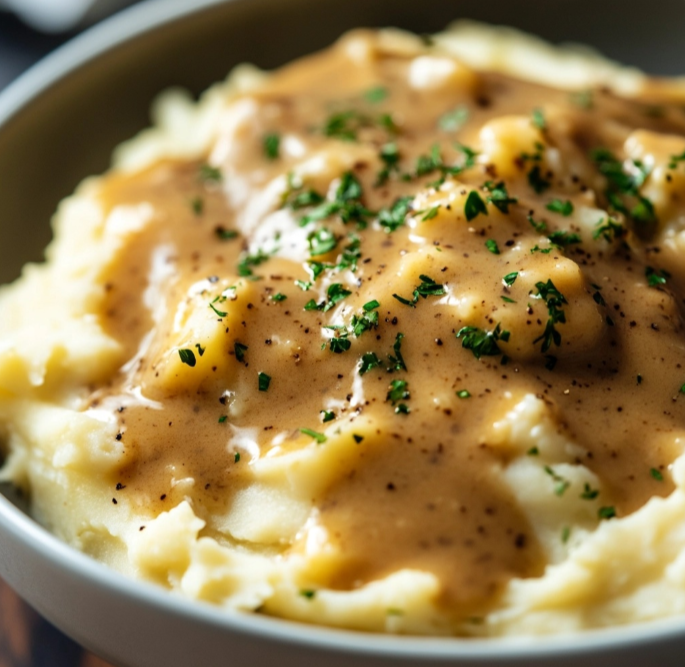Introduction
Mashed potatoes and gravy are a favorite at many dinner tables, known for their comforting taste. This dish combines creamy textures with rich flavors to create a delightful meal. In this guide, we’ll help you choose the best ingredients, prepare them well, and mix them to perfect your mashed potatoes and gravy. We aim to provide you with the tips and techniques needed to improve your cooking skills and ensure your dish is a hit every time.
Choosing Your Potatoes

Picking the right potatoes is key to making great mashed potatoes and gravy. First, think about the texture you want. If you like them creamy, go for Russet or Yukon Gold potatoes. These types are high in starch, which breaks down easily during cooking, making your mash smooth. Make sure your potatoes are fresh—look for ones without green spots or sprouts. Also, choose potatoes that are about the same size to cook them evenly.
- Russet Potatoes: Best for a light, fluffy texture.
- Yukon Gold Potatoes: They have a naturally rich, buttery taste.
- Freshness Check: Avoid any with sprouts or green marks.
Preparing the Potatoes
Getting your potatoes ready is the first step toward tasty mashed potatoes and gravy. Begin by cleaning the potatoes well to get rid of any dirt. You can peel them if you want a smoother mash, but it’s not a must. Cut the potatoes into even pieces so they cook evenly, which is important for a good texture. Boil them in salted water until they are soft, which usually takes about 15-20 minutes. Make sure to drain them well to keep your mash from getting watery.
Mastering the Mash
Once your potatoes are cooked and drained, it’s time to mash them. To make the best mashed potatoes and gravy, use a potato masher or ricer to get the texture you like. Slowly add butter and warm milk to make them tastier and creamier. It’s also key to season them well with salt and pepper. Be careful not to mash too much; too much mashing can make them sticky. Here are a few tips to help you get it right:
- Avoid Underseasoning: Keep tasting and adjusting the seasoning as needed.
- Texture Variations: For a smoother texture, use a ricer.
- Warm Your Add-ins: Warm up the milk and butter before you add them to the mash.
Creating the Perfect Gravy
Making great gravy is as essential as the mashed potatoes. Start with the drippings from a roast, or for a vegetarian option, make a roux using butter and flour. Gradually whisk in stock—chicken, beef, or vegetable—until it thickens. Let it simmer to deepen the flavors, seasoning with salt and pepper as needed. For a richer taste, stir in a bit of cream. Here are some tips for standout gravy:

- Flavor Base: Use high-quality drippings or a carefully prepared roux.
- Consistency: Keep whisking to avoid lumps.
- Final Touches: Fine-tune the seasoning and add cream to enhance the richness.
By following these steps, your mashed potatoes and gravy will not only taste great but will also be enjoyable to make. This process will help you improve your cooking skills and create a dish perfect for any occasion.
Pairing and Serving
Pairing mashed potatoes and gravy with the right dishes can lift the whole meal. They are usually served with roasted meats like turkey, chicken, or beef, especially during holidays. You might also want to add a vegetable side such as steamed broccoli or roasted carrots to bring color and balance to your plate. Here are some great combinations:
- Roasted Meats: They match well with the creamy texture of the potatoes.
- Vegetable Sides: Add vegetables to round out the meal.
- Beverage Pairing: Try a buttery Chardonnay or a crisp beer to complement the flavors.
Tips and Troubleshooting
Sometimes, despite careful preparation, you might run into issues with your mashed potatoes and gravy. If the potatoes are too dry, add a little more milk or butter. too wet, let them cook on low to reduce the moisture. If they’re lumpy, keep mashing or use an electric mixer for a smoother finish. Here’s how to handle these problems:
- Too Dry: Slowly mix in more butter or milk.
- Too Wet: Lower the heat and let the excess moisture evaporate.
- Lumpy Texture: Continue mashing or use a mixer for better smoothness.
Healthy Alternatives: Making Mashed Potatoes and Gravy Healthier
For those looking for healthier versions of mashed potatoes and gravy, there are easy changes you can make without losing flavor. First, choose low-fat milk or a plant-based option like almond or soy milk, which are lighter than whole milk or cream. Also, using olive oil instead of butter cuts down on saturated fats while keeping the rich taste.
Using Healthier Liquids
- Milk Alternatives: Pick almond, soy, or skim milk to cut fat but keep the creamy feel.
- Thickening Agents: Use cornstarch or arrowroot powder as healthy ways to thicken your gravy without using flour.
Choosing Healthier Fats
- Butter Substitute: Olive oil is a great choice that’s good for your heart, providing healthy fats.

Incorporating Vegetables
- Cauliflower Blend: Mix cauliflower with your potatoes to lower carbs and add nutrients like vitamins and minerals.
Making these swaps lets you enjoy mashed potatoes and gravy in a healthier way.
FAQs
Can you eat mashed potatoes with gravy?
Yes, you can enjoy mashed potatoes with gravy. This combo is a classic that brings out the best in both. The gravy adds a rich, tasty twist to the creamy mashed potatoes, making it a favorite for many meals.
What does Gordon Ramsay put in his mashed potatoes?
Gordon Ramsay makes his mashed potatoes with butter, cream, salt, and pepper. He also emphasizes using the right type of potato and the best methods to get them creamy and fluffy.
What is the origin of mashed potatoes and gravy?
Mashed potatoes started in the United Kingdom in the 1600s, likely influenced by recipes from nearby places. Gravy, made from cooked meat juices, has been a key sauce for centuries in various foods. Together, mashed potatoes and gravy became popular as a filling, comforting meal.
Should you use milk or cream in mashed potatoes?
Choosing between milk or cream in mashed potatoes depends on your taste for texture and richness. Milk makes them lighter and fluffier, while cream gives a richer, creamier feel. Both are tasty and can be tweaked to your liking.
Conclusion
Mashed potatoes and gravy are more than just food; they are a cozy reminder of family times and happy celebrations. With this detailed guide, you can master this classic recipe, adapt it to your diet, fix any issues, and enjoy it as part of a great meal. Whether you stick to the traditional way or change it up, this dish is sure to please.

